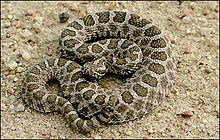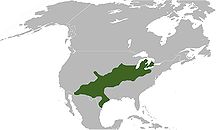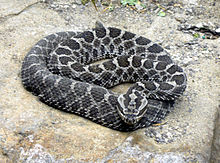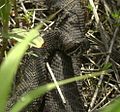- Sistrurus catenatus
-
Sistrurus catenatus 
Conservation status Scientific classification Kingdom: Animalia Phylum: Chordata Subphylum: Vertebrata Class: Reptilia Order: Squamata Suborder: Serpentes Family: Viperidae Subfamily: Crotalinae Genus: Sistrurus Species: S. catenatus Binomial name Sistrurus catenatus
(Rafinesque, 1818)
Synonyms - Crotalinus catenatus - Rafinesque, 1818
- Crotalusrus (Crotalus) catenatus - Rafinesque, 1820
- Crotalus messasaugus - Kirtland In Mather, 1838
- Crotalophorus Kirtlandi - Holbrook, 1842
- Crotalophorus consors - Baird & Girard, 1853
- Crotalophorus Kirtlandi - Baird & Girard, 1853
- Crotalophorus massasauga - Baird, 1854
- C[rotalus]. consors - Coues In Wheeler, 1875
- [Sistrurus] catenatus - Garman, 1884
- [Sistrurus catenatus] Var. consors - Garman, 1884
- Crotalophorus catenatus catenatus - Cope, 1892
- Sistrurus catenatus catenatus - Stejneger, 1895
- Sistrurus catenatus - Boulenger, 1896
- Sistrurus catenatus catenatus - Cope, 1900
- Crotalus messaugus - Golay et al., 1993[1]
Sistrurus catenatus is a venomous pitviper species found primarily in the United States. Three subspecies are currently recognized, including the nominate subspecies described here.[3]
Contents
Description
 S. catenatus, St. Louis zoo.
S. catenatus, St. Louis zoo.
Adults are not large, ranging from 45 to 75 cm (18 to 30 inches) in length. Its color pattern consists of a grey or tan groundcolor with a row of large rounded brown/black blotches or spots down the centre of the back and three smaller rows of alternating spots down each side. Solid black melanistic examples are also known, as well as cases where the back blotches join with those on the sides. Young massasauga are well-patterned but paler than the adults. This is the only Ontario snake with vertical pupils.[citation needed] It has heat-sensing pits on each side of its smallish head, the scales are keeled and the anal scale is single.
Common names
Massasauga, black massasauga, black rattler, black snapper, gray rattlesnake (Iowa, fide Guthrie, 1927), little gray rattlesnake (Canada), muck rattler, prairie rattlesnake, pygmy rattler, spotted rattler, swamp rattler, víbora de cascabel (Mexico),[2] dwarf prairie rattlesnake, eastern massasauga, great adder, ground rattlesnake, Kirtland's rattlesnake, little black rattlesnake (Barton, 1805), massasauga rattlesnake, massasauger, prairie massasauga, rattlesnake, small prairie rattlesnake, snapper, swamp massasauga, swamp rattlesnake, triple-spotted rattlesnake,[4] mississauga.[5]
This is the only venomous snake in Michigan, where it is known as the Michigan rattler, and in Ontario.
The name massasauga means "great river-mouth" in the Chippewa language and was probably given to describe its habitat in Chippewa country: swampland surrounding river deltas.[6]
Geographic range
Found in North America from southwestern Ontario (Canada) and western New York State southwest to southeastern Arizona (USA) and northern Tamaulipas (Mexico). In Mexico, isolated populations exist in southern Nuevo León, north-central Coahuila and in Samalayuca, Chihuahua.[7] It occurs in various habitats ranging from swamps and marshes to grasslands, usually below 1500 m elevation. The type locality given is "... on the prairies of the upper Missouri" (Valley, USA).[1]
According to Campbell and Lamar (2004), a population also exists in southeastern Colorado that is morphologically somewhat intermediate between S. c. tergeminus and S. c. edwardsii.[2]
Conservation status
This species is classified as Least Concern (LC) on the IUCN Red List of Threatened Species (v3.1, 2001).[8] Species are listed as such due to their wide distribution, presumed large population, or because it is unlikely to be declining fast enough to qualify for listing in a more threatened category. The population trend is unknown. Year assessed: 2007.[9]
It is listed in a number of states as an endangered species, although it does not have any designation on the United States federal Endangered Species Act. The two subspecies found in the drier areas of the southwestern United States and northern Mexico are also considered endangered or at risk by some[who?] state governments.[citation needed]
In Ontario, the species is found only near the eastern shore of Georgian Bay, the Bruce Peninsula, Wainfleet Bog and Ojibway Prairie (Rouse, J.D. and Willson, R.J. 2001. Update COSEWIC Status Report on the Eastern Massasauga, Sistrurus catenatus catenatus. Prepared for the Committee of the Status of Endangered Wildlife in Canada (COSEWIC), November 2001. v+18pp.). It is becoming rare in Canada due to persecution and loss of habitat and is designated as Threatened by the Committee on the Status of Endangered Wildlife in Canada (COSEWIC)[10], as well as the Committee on the Status of Species-at-Risk in Ontario (COSSARO).
Feeding
The diet consists of a variety of small vertebrates, including mammals, lizards and snakes, as well as invertebrates such as centipedes. However, mammals and reptiles make up their bulk of their diet. Adults feed mainly on rodents, while juveniles usually prey on reptiles: more often lizards in western populations and snakes in eastern ones. Frogs also constitute an important part of their diet: Ruthven (1928) mentioned that in Michigan they made up the main portion of their diet. According to Klauber (1956), S. catenatus feeds on frogs more frequently than any other rattlesnake. In general, however, frogs are not an important part of the diet, although this does seem to be more typical in certain northern and eastern populations.[2]
Venom
The venom of rattlesnakes contains specialized digestive enzymes that disrupt blood flow and prevent blood clotting. Severe internal bleeding causes the death of the small animals that this snake eats. After envenomation, the rattlesnake is able to withdraw from the dangers of sharp toothed prey animals until they are subdued and even partially digested by the action of the venom.
S. c. catenatus is rather shy and avoids humans when it can. Most massasauga snakebites in Ontario have occurred after people deliberately handled or accidentally stepped on one of these animals.[citation needed] Both of these scenarios are preventable by avoiding hiking through areas of low visibility (in rattlesnake country) when not wearing shoes and long pants, and by leaving the massasaugas alone when they are found. There are only two recorded incidents of people dying from massasauga rattlesnake bites in Ontario and in both cases they did not receive proper treatment.[11]
Subspecies
Subspecies[3] Taxon author[3] Common name[12] Geographic range[2][4][12] S. c. catenatus (Rafinesque, 1818) Eastern Massasauga United States: central and western New York south of Lake Ontario, western Pennsylvania, northern and central Ohio, northern Indiana, lower Michigan, Illinois, southern and southwestern Wisconsin, extreme southeastern Minnesota, eastern Iowa and northeastern Missouri. Canada: southern Ontario along the shores of Georgian Bay, Lake Huron and Lake Erie.
S. c. edwardsii (Baird & Girard, 1853) Desert Massasauga United States: extreme southeastern Arizona, central and southern New Mexico, western Texas about as far north and east as the Colorado River, in the Rio Grande Valley, in many of the Gulf Coast counties about as far north as Brazoria, and on several barrier islands including North Padre Island, Matagorda Island and San José Island. Mexico: isolated populations have been reported in the northeast of the country. S. c. tergeminus (Say, 1823) Western Massasauga United States: in the southwestern plains from extreme southeastern Nebraska and northwestern Missouri, southwest through east-central Kansas and west-central Oklahoma into northern and central Texas about as far southwest as the Colorado River. Gallery
Images of S. c. catenatus:
See also
- List of crotaline species and subspecies
- Crotalinae by common name
- Crotalinae by taxonomic synonyms
- Snakebite
References
- ^ a b McDiarmid RW, Campbell JA, Touré T. 1999. Snake Species of the World: A Taxonomic and Geographic Reference, vol. 1. Herpetologists' League. 511 pp. ISBN 1-893777-00-6 (series). ISBN 1-893777-01-4 (volume).
- ^ a b c d e Campbell JA, Lamar WW. 2004. The Venomous Reptiles of the Western Hemisphere. Comstock Publishing Associates, Ithaca and London. 870 pp. 1500 plates. ISBN 0-8014-4141-2.
- ^ a b c "Sistrurus catenatus". Integrated Taxonomic Information System. http://www.itis.gov/servlet/SingleRpt/SingleRpt?search_topic=TSN&search_value=174304. Retrieved 30 January 2007.
- ^ a b Wright AH, Wright AA. 1957. Handbook of Snakes. Comstock Publishing Associates. (7th printing, 1985). 1105 pp. ISBN 0-8014-0463-0.
- ^ Method Of Creating Antigens Using Emus at World Intellectual Property Organization. Accessed 8 January 2008.
- ^ Behler JL, King FW. 1979. The Audubon Society Field Guide to North American Reptiles and Amphibians. New York: Alfred A. Knopf. 743 pp. LCCCN 79-2217. ISBN 0-394-50824-6.
- ^ Report on Samalayuca Fauna Reporte de Fauna de la Region de Samalayuca UACJ
- ^ Sistrurus catenatus at the IUCN Red List. Accessed 15 September 2007.
- ^ 2001 Categories & Criteria (version 3.1) at the IUCN Red List. Accessed 15 September 2007.
- ^ http://www.sararegistry.gc.ca/species/speciesDetails_e.cfm?sid=277
- ^ http://www.massasauga.ca/pub_docs/Snake_Safety_Tips.pdf
- ^ a b Klauber LM. 1997. Rattlesnakes: Their Habitats, Life Histories, and Influence on Mankind. Second Edition. First published in 1956, 1972. University of California Press, Berkeley. ISBN 0-520-21056-5.
Further reading
- Ontario Snakes, Ontario Ministry of Natural Resources, Toronto, 1981. Pp. 36.
- Behler JL, King FW. 1979. The Audubon Society Field Guide to North American Reptiles and Amphibians. New York: Alfred A. Knopf. 743 pp. LCCCN 79-2217. ISBN 0-394-50824-6.
External links
- Sistrurus at the Reptarium.cz Reptile Database. Accessed 15 September 2007.
- Eastern Massasauga Fact Sheet at New York State Dept. of Environmental Conservation. Accessed 14 December 2008.
- Massasauga at Encyclopædia Britannica. Accessed 22 June 2005.
- Eastern Massasauga at Learn Anumals. Accessed 30 January 2007.
- Sistrurus catenatus at Herps of Texas. Accessed 30 January 2007.
- Eastern Massasauga in Killbear Provincial Park at Borka's page. Accessed 30 January 2007.
- Massasauga Rattlesnake - Sistrurus catenatus at Herpnet.net, Reptiles and Amphibians of Iowa. Accessed 15 June 2007.
- Eastern Massasauga Rattlesnake (Sistrurus catenatus catenatus), Natural Resources Canada
Categories:- IUCN Red List least concern species
- Crotalinae
- Fauna of Canada
- Reptiles of the United States
- Reptiles of Ontario
Wikimedia Foundation. 2010.







